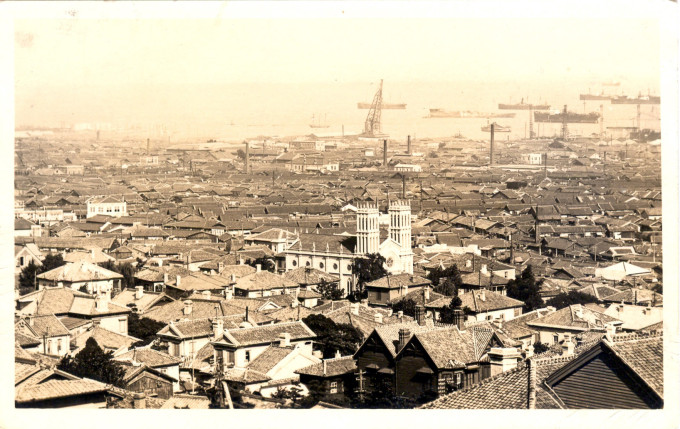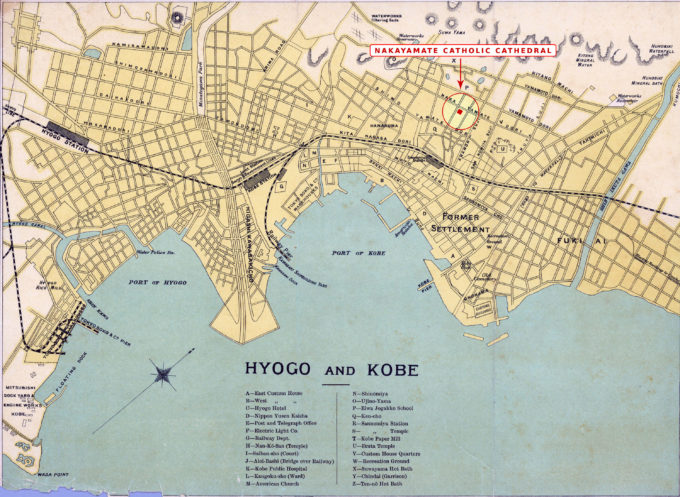“The Port of Kobe was opened to foreign trade on January 1st, 1863. Prior to that date the part particularly known as Kobe was occupied by three old villages containing in all about one thousand houses; but in 1868 the town was incorporated. With the passing of the new regulations for gun (county), ku (division), cho (town), and mura (village) the towns of Kobe and Hiogo in 1878 were constituted one, called Kobe-ku. In April 1889 however, it was made Kobe-Shi, the City of Kobe.
“The sudden growth of the town after the Restoration was due to the opening of Japan to foreign trade, and its present position as the second port of the Empire is owing to its proximity to the continent, its spacious harbour, and splendid situation as a distributing centre.
“The harbour is deservedly known as the ‘Gate of the Orient’ and has long been the radiating point for national and foreign commerce, The place is enjoying an unprecedented prosperity already but in about two years [i.e. circa 1920], when the harbour re-construction is complete, it is thought possible that its foreign trade may even rival that of Shanghai.”
– Hyogo Prefecture and the City of Kobe, Panama-Pacific International Exposition, 1915

Aerial view of Kobe and its bustling harbor, c. 1925, with the twin-towered Nakayamate Catholic Cathedral at center. The Cathedral was completed in 1922 and consecrated in 1923. It was partially destroyed by fire during a June 1945 air raid on the city during the Pacific War. Severely damaged in the 1995 Great Hanshin earthquake, the Cathedral was demolished and, following the post-earthquake merger of three Catholic congregations, replaced with a new structure on the site – Kobe Central Catholic Church.
See also:
Hiogo Baptist Church, c. 1910.
Kobe Chamber of Commerce & Industry, Kobe, c. 1930.
Ikariyama (“Anchor Mountain”), Kobe, c. 1910.
Tor Hotel, Kobe, c. 1910-1930.
Kobe harbor, c. 1910.
“The port city that would eventually be named Kobe in 1889 has a long history. From ancient times the port city developed due to numerous factors: its position on the Seto Inland Sea, Kobe’s central location in Japan, its deep harbor waters, and its mild climate.
“During the Nara Period (710-784 C.E.), the port, known then as ‘Owada no Tomari’, was already a major port of trade with China and other foreign countries. In addition to trade, the beautiful coastline of Suma and Maiko, located in western Kobe, served as the backdrop for many waka and haiku poems, as well as other famous literary works such as The Tale of Genji (from approximately late 9th century to early 10th century) and the Taiheiki (14th century).
“For a short time, the capital of Japan was moved from Kyoto to Kobe’s Fukuhara. At the same time, Kobe became a center of military activity. Many famous battles between the Heiki and Genji clans occurred here, including the Battle of Ichi no Tani in 1184.
“In later years, Kobe’s port was to play an important role as a sea traffic center for both the Seto Inland Sea and the Japan Sea. It was also a rest station along the Saigoku Highway – a major highway that went from the capital, Kyoto, to western Japan. Toyotomi Hideyoshi, the great general and unifier of 16th century Japan, loved the Arima Hot Springs just north of Kobe and visited them often.
“Kobe also flourished during the Edo Period (1603-1867). Using its ideal natural environment, it became a sake-making center; ‘Nada no Ki Ippon’ sake became famous throughout Japan. To this day Kobe is proud to be the number-one sake producing area in the country.
“After a long period of national isolation, Japan opened its doors to the world following the arrival of Americans Commodore Matthew Perry and Townsend Harris. The opening of the Port of Kobe on January 1, 1868 allowed Kobe to develop into an international port city; during the Meiji period, Kobe established itself as one of Japan’s major ports.
“After the opening of the port, many Americans and Europeans came to Kobe, establishing a Foreigners’ Settlement. Through them, Western food, clothes, and entertainment found their way into Japanese culture, making Kobe one of the first cities in Japan to be introduced to foreign culture. Kobe is also known as the birthplace of jazz and the cinema in Japan. Other products developed in Kobe during this time include clothes, furniture, confectioneries, and beef, which remain signature goods of Kobe to this day.”
– Kobe Trade Information Office, (undated)



Pingback: “Great Kobe Harbour”, c. 1960. | Old TokyoOld Tokyo